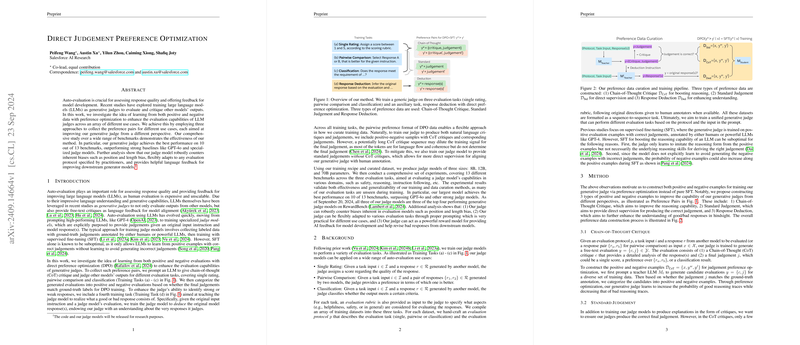Direct Judgment Preference Optimization
The paper "Direct Judgement Preference Optimization" by Wang et al. presents a sophisticated approach to enhancing the evaluation capabilities of LLM judges. By leveraging a method that trains these models through preference optimization using both positive and negative examples, the paper addresses several critical challenges associated with model evaluation. This essay will provide a detailed overview of the paper, focusing on the methodologies employed, the experimental results obtained, and the implications for future developments in AI.
The primary focus of the paper is on auto-evaluation, which is pivotal for assessing the quality of model responses and providing feedback for further model development. Human evaluations, while accurate, are expensive and unscalable. Therefore, the utilization of LLMs as generative judges—models that not only assess but also critique other models' outputs—is presented as a feasible alternative.
Methodology
The approach proposed by Wang et al. builds on the existing supervised fine-tuning (SFT) techniques by integrating direct judgement preference optimization (DPO). The essence of this methodology is to train generative judges not just on correctly labeled data but also on data where incorrect judgments are explicitly noted and avoided.
Data Collection and Tasks
Three primary training tasks are identified:
- Chain-of-Thought (CoT) Critique: Here, an LLM is prompted to provide detailed evaluations and final judgments on responses. Positive examples are those where the judgment aligns with ground-truth annotations, while negative examples do not. This structure aims to improve the model's reasoning capabilities.
- Standard Judgement: This task involves generating judgements without the detailed CoT critiques, focusing on directly learning from correct and incorrect judgments to refine the model's decision-making precision.
- Response Deduction: An auxiliary task where the model is trained to deduce the original responses given the model's evaluations. This reverse-engineering process bolsters the model’s understanding of what constitutes good or bad responses.
The model is trained using these preference pairs across a variety of datasets, ensuring a wide coverage of evaluation tasks like single rating, pairwise comparison, and classification. This comprehensive dataset aids in the generalizability of the trained judge model across different domains.
Experimental Results
Experiments demonstrate the efficacy of the proposed method across 13 benchmarks encompassing safety, reasoning, and instructional tasks. The results are striking:
- The largest model achieves best performance in 10 out of 13 benchmarks, outperforming established models like GPT-4o and other specialized judge models.
- The models show robustness against biases such as position and length bias.
- The judge models are adaptable to various evaluation protocols and provide actionable feedback for improving downstream models.
Bias Analysis and Prompt Robustness
The paper also explores the inherent biases present in evaluation models. The trained judge models, referred to as SFR-Judges, show notable reductions in biases compared with other existing models. The analysis includes a breakdown of performance across different bias categories in EvalBiasBench and pairwise comparison consistency metrics.
Additionally, the flexibility of SFR-Judges in adapting to different prompting styles—whether task-specific or general—ensures their broad applicability. The models maintained their performance levels across varying prompts, showcasing their robustness and reliability.
Implications and Future Directions
The implications of this research are far-reaching:
- Practical Impact: The ability to provide reliable, bias-mitigated evaluations can significantly streamline the model development lifecycle, making the training and refinement of LLMs more efficient and cost-effective.
- Theoretical Advancements: The integration of DPO in training generative judges represents a notable shift from purely SFT methodologies, highlighting the benefits of learning from both correct and incorrect examples.
- Future Developments: Potential future work might explore scaling these models further, integrating more diverse datasets, and refining the DPO techniques to handle increasingly complex evaluation tasks.
In conclusion, the paper by Wang et al. offers a comprehensive and effective strategy for enhancing the capabilities of LLM judges. By introducing a multi-faceted training approach that includes both reasoning and judgement-specific tasks, the proposed models achieve remarkable performance and adaptability. This work not only advances the state of auto-evaluation in AI but also sets a new benchmark for training and utilizing generative judge models in future AI development endeavors.
